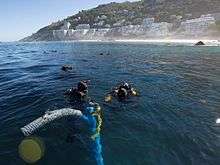São José Paquete Africa
| History | |
|---|---|
| Name: | São José Paquete Africa |
| Fate: | Sank: December 27, 1794 |

The São José Paquete Africa (also, São José-Paquete de Africa) was a slave ship from the Kingdom of Portugal that sank in 1794 off the coast of Cape Town, South Africa. Close to shore, but in deep water, 212 of the 400 to 500 African slaves who were aboard died when the ship sank.[1] In 2015, the Smithsonian's African American History Museum, South Africa's Iziko Museums, the Slave Wrecks Project, and other partners, confirmed discovery of the wreck near where it sank.[2][3] The ship and its slaves were headed from Portuguese Mozambique to Colonial Brazil, during the height of the international African slave trade.[4] Few other former slave ships have been found, but the São José is the first and only shipwreck discovered, as of June 3, 2015, of a working slave ship, which sank in transit with its human cargo aboard.[4][5]
History

On April 27, 1794, the São José sailed from Lisbon, Portugal, captained by Manuel Joao Perreira. In its hold were a load of carefully calibrated iron ballasts that sailing ships required in order to effectively transport on the open ocean the shifting weight of hundreds of individual captive humans. The ship's destination, the Portuguese colony of Mozambique in southeastern Africa, was a relatively new source of slave labor for the Atlantic slave trade. The São José is one of the first known ships to attempt the long-distance voyage from Portugal to Mozambique to Brazil.
The ship’s path represents European slave traders’ increased efforts to obtain slaves. More than two centuries of slave trade along Africa’s west coast reduced the population, and along with increasing competition, motivated Portugal to send ships 7,000 miles to one of the farthest, cheapest sources of slaves in the trans-Atlantic trade, Mozambique, Africa, and then ship the slaves around the Cape of Africa to Brazil.[6]
In early December, at the port on the Island of Mozambique, the ship's crew loaded their human cargo and got under way. The enslaved men, women and children were likely from the interior of Mozambique. Their travel in the slave hold to Maranhão, Brazil, was set to take some four months.[3] The journey lasted only a few weeks.
The ship was attempting to make its way through the difficult waters off the Cape at about 2:00 a.m. December 27. Near Camps Bay, it ran into submerged rocks about 100 meters (330 ft) from shore. With the ship in distress, the crew raised the alarm by firing the cannons. A barque with some of the human cargo was able to reach the safety of the Cape Colony. Relays of ropes with baskets were also employed to help save lives but the ship broke into pieces about 5:00. The captain and all the crew were rescued, but hundreds of the slaves drowned, possibly in their iron shackles. The surviving ones were soon sold in the Cape Colony.[3][7]
Discovery

Local divers found the wreck in the 1980s but misidentified it as a Dutch merchant ship. Discoveries in archives in South Africa and Portugal, as well as tests of artifacts confirmed in 2015 that the ship was the São José slave ship. On June 3, 2015, along with the formal announcement of the find, a memorial service was held for the lost. Three divers from South Africa, the United States, and Mozambique scattered soil from the slaves' homeland in the surf not far from the wreck. Artifacts from the dive site displayed at the South Africa's Iziko Museum's Slave Lodge in June 2015, will undergo conservation efforts there, and additional research and recovery will continue.[8] Some artifacts will be loaned for display at the United States' African American History Museum, when it opens in 2016.[9][10][11] Connected with the 2015 anniversary of the abolition of slavery in South Africa and the work on the Sao Jose, the Iziko launched a new website exhibition, Slavery in South Africa.[12]
References
- ↑ Cooper, Helene (May 31, 2015). "Grim History Traced in Sunken Slave Ship Found Off South Africa". The New York Times. Retrieved June 2, 2015.
- ↑ Sanders, Sam (May 31, 2015). "Wreck Of A 221-Year-Old Slave Ship Is Confirmed Off South Africa". NPR.
- 1 2 3 Smith, David (June 2, 2015). "South Africans honour slaves drowned in 1794 shipwreck". Mail & Guardian. Retrieved June 3, 2015.
- 1 2 Gass, Henry (June 1, 2015). "Wreck of slave ship: Why the São José fascinates". The Christian Science Monitor. ISSN 0882-7729. Retrieved June 3, 2015.
- ↑ Catlin, Roger (May 31, 2015). "Smithsonian to Receive Artifacts From Sunken 18th-Century Slave Ship Found Off the Coast of South Africa". Retrieved June 3, 2015.
- ↑ Weber, Greta (June 5, 2015). "Shipwreck Shines Light on Historic Shift in Slave Trade". National Geographic News. Retrieved 2015-06-08.
- ↑ Ingeno, Lauren (June 10, 2015). "Archaeologist resurfaces stories from a sunken slave ship". phys.org.
- ↑ "Slave Wreck Artefacts on Display". iziko.org.za. Iziko Museums of South Africa. June 5, 2015. Retrieved June 12, 2015.
- ↑ Torchia, Christopher (June 2, 2015). "Slaves who died in 1794 Cape Town shipwreck are remembered". Chicago Tribune. Associated Press. Retrieved June 3, 2015.
- ↑ McGlone, Peggy (May 30, 2015). "‘Humble objects’ of a sunken slave ship tell a powerful and emotional story". The Washington Post. ISSN 0190-8286. Retrieved June 3, 2015.
- ↑ Davis, Rebecca. "Of sunken slave ships and neo-imperialism". Daily Maverick. Retrieved June 3, 2015.
- ↑ http://www.iziko.org.za/news/entry/iziko-commemorates-the-abolition-of-slavery-in-south-africa/
External links
| Wikimedia Commons has media related to São José Paquete Africa. |